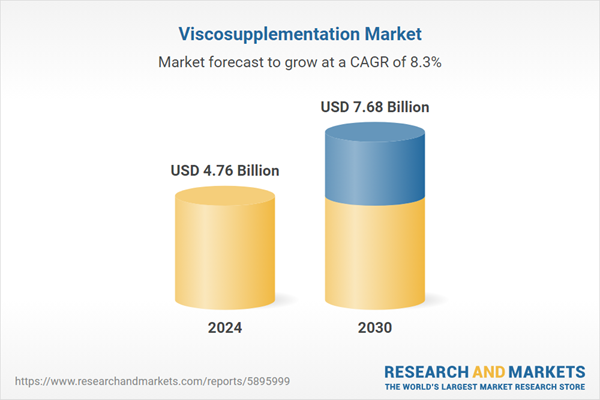Free Webex Call
The Viscosupplementation Market was valued at USD 4.76 Billion in 2024, and is expected to reach USD 7.68 Billion by 2030, rising at a CAGR of 8.25%. This growth is primarily attributed to the increasing incidence of osteoarthritis and other musculoskeletal disorders, particularly among the aging population. Viscosupplementation, which involves injecting hyaluronic acid-based solutions into joints, offers a minimally invasive alternative to surgical interventions, enhancing mobility and reducing joint pain. The market is further supported by advancements in product development and the broadening of applications beyond knee osteoarthritis to other joints. Rising cases of sports-related injuries and the global shift toward non-surgical treatment options have also fueled demand. However, high treatment costs and inconsistent insurance reimbursement policies continue to pose barriers to widespread adoption in some regions. Speak directly to the analyst to clarify any post sales queries you may have.
10% Free customizationThis report comes with 10% free customization, enabling you to add data that meets your specific business needs.
Key Market Drivers
Rising Aging Population
One of the most influential factors driving growth in the global viscosupplementation market is the rising aging population. According to the United Nations Department of Economic and Social Affairs, the global population aged 60 and above is projected to reach 2.1 billion by 2050, up from 1.2 billion in 2024. This age group is highly susceptible to osteoarthritis (OA), a major condition treated with viscosupplementation.Statistics show that 43% of individuals with OA are aged 65 or older, while 88% are aged 45 or older. The 55-64 age group reports the highest annual incidence of knee OA, positioning them as a key demographic for viscosupplementation therapy. As this segment of the population grows, so does the demand for effective, non-surgical joint treatments to improve mobility and quality of life. This demographic trend supports the long-term expansion of the viscosupplementation market.
Key Market Challenges
High Treatment Cost
The elevated cost of viscosupplementation treatments presents a major challenge for market expansion. These treatments often require multiple injections over time, especially for chronic conditions like osteoarthritis, leading to recurring expenses. This becomes a financial burden for patients lacking sufficient insurance coverage and creates reimbursement hurdles for healthcare providers. In some healthcare systems, limited insurance policies or delays in reimbursement further deter the adoption of these therapies. The high cost may prompt patients to pursue more affordable alternatives such as medications or physical therapy. To mitigate this issue, the market must focus on enhancing cost-efficiency through pricing strategies, improved insurance coverage, and patient education regarding the long-term benefits of viscosupplementation over other management options for joint pain.Key Market Trends
Biocompatible Hyaluronic Acid (HA) Derivatives
A notable trend in the Viscosupplementation Market is the increasing development and use of biocompatible hyaluronic acid (HA) derivatives. These derivatives are engineered to replicate the properties of natural HA more closely, offering longer-lasting joint lubrication and improved pain relief. By minimizing injection frequency and maximizing therapeutic outcomes, these products enhance patient compliance and comfort.Additionally, their improved safety profile - due to a lower likelihood of adverse reactions - makes them more favorable for long-term use. Patients benefit from extended relief and reduced joint inflammation, resulting in better mobility and higher satisfaction. Manufacturers are investing in research to develop advanced HA derivatives that offer more effective, durable, and convenient treatment options. This trend is expected to reshape osteoarthritis care by providing innovative solutions that improve patient outcomes and treatment experiences.
Key Market Players
- Sanofi SA
- Seikagaku Corporation
- Smith & Nephew PLC.
- Lifecore Biomedical, LLC.
- Fidia Farmaceutici S.p.A
- F. Hoffmann-La Roche Ltd.
- LG Life Sciences Ltd.
- Ferring Pharmaceutical B.V.
- Zimmer Biomet Holdings Inc
- Anika Therapeutics, Inc.
Report Scope:
In this report, the Global Viscosupplementation Market has been segmented into the following categories, in addition to the industry trends which have also been detailed below.Viscosupplementation Market, By Product Type:
- Single Injection
- Three Injection
- Five Injection
Viscosupplementation Market, By End User:
- Hospitals
- Orthopedic Clinics/ASCs
Viscosupplementation Market, By Region:
- North America
- United States
- Canada
- Mexico
- Europe
- France
- United Kingdom
- Italy
- Germany
- Spain
- Asia-Pacific
- China
- India
- Japan
- Australia
- South Korea
- South America
- Brazil
- Argentina
- Colombia
- Middle East & Africa
- South Africa
- Saudi Arabia
- UAE
Competitive Landscape
Company Profiles: Detailed analysis of the major companies present in the Global Viscosupplementation Market.Available Customizations:
With the given market data, the publisher offers customizations according to a company's specific needs. The following customization options are available for the report.Company Information
- Detailed analysis and profiling of additional market players (up to five).
This product will be delivered within 1-3 business days.
Table of Contents
1. Product Overview
2. Research Methodology
3. Executive Summary
5. Viscosupplementation Market Outlook
6. North America Viscosupplementation Market Outlook
7. Europe Viscosupplementation Market Outlook
8. Asia-Pacific Viscosupplementation Market Outlook
9. South America Viscosupplementation Market Outlook
10. Middle East and Africa Viscosupplementation Market Outlook
11. Market Dynamics
12. Market Trends & Developments
14. Porter’s Five Forces Analysis
16. Competitive Landscape
Companies Mentioned
- Sanofi SA
- Seikagaku Corporation
- Smith & Nephew PLC.
- Lifecore Biomedical, LLC.
- Fidia Farmaceutici S.p.A
- F.Hoffmann-La Roche Ltd.
- LG Life Sciences Ltd.
- Ferring Pharmaceutical B.V.
- Zimmer Biomet Holdings Inc
- Anika Therapeutics, Inc.
Table Information
| Report Attribute | Details |
|---|---|
| No. of Pages | 184 |
| Published | April 2025 |
| Forecast Period | 2024 - 2030 |
| Estimated Market Value ( USD | $ 4.76 Billion |
| Forecasted Market Value ( USD | $ 7.68 Billion |
| Compound Annual Growth Rate | 8.2% |
| Regions Covered | Global |
| No. of Companies Mentioned | 10 |









